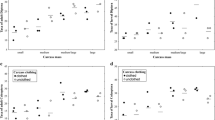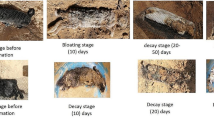Abstract
The level of exposure or concealment of a cadaver is known to have an important impact on insect colonisation and decomposition but has been the subject of few investigations. In the present study, 30 pig carcasses were stored in three different types of containers (suitcases, trashcans and drums) with different levels of access for necrophagous insects at two different geographic locations for 100 days. The decomposition proceeded in a similar way in both geographic locations in all three types of container. Both in trashcans and suitcases, the decomposition process was characterised by bones and greasy, brown decomposition fluids left in the containers and an overall moist decomposition. In contrast, decomposition in the drums was characterised by a long bloating phase followed by a slow transition from bloated to deflation. Tissue and the carcasses as a whole were still present till the end of the experiment. Insect occurrence patterns and species composition on suitcases and trashcans were similar for both countries. Mainly flies and some beetles were present in suitcases and trashcans until day 45, with blow flies (Diptera: Calliphoridae) dominating the fauna. There was no insect colonisation in the drums. Our study contributes to the knowledge about insect accessibility of concealed cadavers and the impact of concealment on the speed and type of decomposition. It clearly shows that the degree of exposure of a cadaver is a key factor in decomposition and insect colonisation, which had a larger effect here than the biogeographical location.






Similar content being viewed by others
References
Cockle DL, Bell LS (2015) Human decomposition and the reliability of a “universal” model for post mortem interval estimations. Forensic Sci Int 253:136.e1–136.e9. https://doi.org/10.1016/j.forsciint.2015.05.018
Gelderman HT, Boer L, Naujocks T, IJzermans ACM, Duijst WLJM (2017) The development of a post-mortem interval estimation for human remains found on land in the Netherlands. Int J Legal Med 132:863–873. https://doi.org/10.1007/s00414-017-1700-9
Michaud JP, Moreau G (2011) A statistical approach based on accumulated degree-days to predict decomposition-related processes in forensic studies. J Forensic Sci 56:229–232. https://doi.org/10.1111/j.1556-4029.2010.01559.x
Cockle DL, Bell LS (2017) The environmental variables that impact human decomposition in terrestrially exposed contexts within Canada. Sci Justice 57:107–117. https://doi.org/10.1016/j.scijus.2016.11.001
Mann RW, Bass WM, Meadows L (1990) Time since death and decomposition of the human body: variables and observations in case and experimental field studies. J Forensic Sci 35:103–111. https://doi.org/10.1520/JFS12806J
Sharanowski BJ, Walker EG, Anderson GS (2008) Insect succession and decomposition patterns on shaded and sunlit carrion in Saskatchewan in three different seasons. Forensic Sci Int 179:219–240. https://doi.org/10.1016/J.FORSCIINT.2008.05.019
Reh H, Haarhoff K, Vogt CD (1977) Die Schätzung der Todeszeit bei Wasserleichen. Z Rechtsmed 79:261–266. https://doi.org/10.1007/BF00201166
Madea B, Doberentz E (2010) Commentary on: Heaton V, Lagden A, Moffatt C, Simmons T. Predicting the postmortem submersion interval for human remains recovered from U.K. waterways. J Forensic Sci 2010;55(2):302-7. J Forensic Sci 55:1666–1667. https://doi.org/10.1111/j.1556-4029.2010.01517.x
Cross P, Simmons T (2010) The influence of penetrative trauma on the rate of decomposition. J Forensic Sci 55:295–301. https://doi.org/10.1111/j.1556-4029.2009.01277.x
Sutherland A, Myburgh J, Steyn M, Becker PJJ (2013) The effect of body size on the rate of decomposition in a temperate region of South Africa. Forensic Sci Int 231:257–262. https://doi.org/10.1016/j.forsciint.2013.05.035
Matuszewski S, Konwerski S, Frątczak K, Szafałowicz M (2014) Effect of body mass and clothing on decomposition of pig carcasses. Int J Legal Med 128:1039–1048. https://doi.org/10.1007/s00414-014-0965-5
Vass AA (2011) The elusive universal post-mortem interval formula. Forensic Sci Int 204:34–40. https://doi.org/10.1016/j.forsciint.2010.04.052
Pietro CC, Di Vella G (2001) Factors affecting descomposition Diptera colonization. Forensic Sci Int Genet Suppl Ser 120:18–27
Michaud JP, Moreau G (2017) Facilitation may not be an adequate mechanism of community succession on carrion. Oecologia 183:1143–1153. https://doi.org/10.1007/s00442-017-3818-3
Amendt J, Krettek R, Zehner R (2004) Forensic entomology. Naturwissenschaften 91:51–65. https://doi.org/10.1007/s00114-003-0493-5
Madra A, Fratczak K, Grzywacz A, Matuszewski S (2015) Long-term study of pig carrion entomofauna. Forensic Sci Int 252:1–10. https://doi.org/10.1016/j.forsciint.2015.04.013
Payne JA (1965) A summer carrion study of the baby pig Sus Scrofa Linnaeus. Ecology 46:592–602. https://doi.org/10.2307/1934999
Matuszewski S, Bajerlein D, Konwerski S, Szpila K (2010) Insect succession and carrion decomposition in selected forests of Central Europe. Part 1: pattern and rate of decomposition. Forensic Sci Int 194:85–93. https://doi.org/10.1016/j.forsciint.2009.10.016
Pastula EC, Merritt RW (2013) Insect arrival pattern and succession on buried carrion in Michigan. J Med Entomol 50:432–439. https://doi.org/10.1603/ME12138
Kelly JA, Van Der Linde TC, Anderson GS (2009) The influence of clothing and wrapping on carcass decomposition and arthropod succession during the warmer seasons in Central South Africa. J Forensic Sci 54:1105–1112. https://doi.org/10.1111/j.1556-4029.2009.01113.x
Gunn A, Bird J (2011) The ability of the blowflies Calliphora vomitoria (Linnaeus), Calliphora vicina (Rob-Desvoidy) and Lucilia sericata (Meigen) (Diptera: Calliphoridae) and the muscid flies Muscina stabulans (Fallén) and Muscina prolapsa (Harris) (Diptera: Muscidae) to colo. Forensic Sci Int 207:198–204. https://doi.org/10.1016/j.forsciint.2010.10.008
Szpila K, Voss JG, Pape T (2010) A new dipteran forensic indicator in buried bodies. Med Vet Entomol 24:278–283. https://doi.org/10.1111/j.1365-2915.2010.00883.x
Kelly JA, Van Der Linde TC, Anderson GS (2008) The influence of clothing and wrapping on carcass decomposition and arthropod succession: a winter study in Central South Africa. Can Soc Forensic Sci J 41:135–147. https://doi.org/10.1080/00085030.2008.10757171
Goff ML (1992) Problems in estimation of postmortem interval resulting from wrapping of the corpse: a case study from Hawaii. J Agric Entomol 9:237–243
Voss SC, Forbes SL, Dadour IR (2008) Decomposition and insect succession on cadavers inside a vehicle environment. Forensic Sci Med Pathol 4:22–32. https://doi.org/10.1007/s12024-007-0028-z
Bhadra P, Hart AJ, Hall MJR (2014) Factors affecting accessibility to blowflies of bodies disposed in suitcases. Forensic Sci Int 239:62–72. https://doi.org/10.1016/j.forsciint.2014.03.020
Bourel B, Tournel G, Hédouin V, Gosset D (2004) Entomofauna of buried bodies in northern France. Int J Legal Med 118:215–220. https://doi.org/10.1007/s00414-004-0449-0
Mariani R, García-Mancuso R, Varela GL, Inda AM (2014) Entomofauna of a buried body: study of the exhumation of a human cadaver in Buenos Aires, Argentina. Forensic Sci Int 237:19–26. https://doi.org/10.1016/j.forsciint.2013.12.029
Charabidze D, Hedouin V, Gosset D, De Meyer M (2015) An experimental investigation into the colonization of concealed cadavers by necrophagous blowflies. J Insect Sci 15:1–7. https://doi.org/10.1093/jisesa/iev129
Spivak M, Conlon D, Bell WJ (1991) Wind-guided landing and search behavior in fleshflies and blowflies exploiting a resource patch (Diptera: Sarcophagidae, Calliphoridae). Ann Entomol Soc Am 84:447–452
Ashworth JR, Wall R (1994) Responses of the sheep blowflies Lucilia sericata and L. cuprina to odour and the development of semiochemical baits. Med Vet Entomol 8:303–309. https://doi.org/10.1111/j.1365-2915.1994.tb00093.x
Michaud JP, Moreau G (2009) Predicting the visitation of carcasses by carrion-related insects under different rates of degree-day accumulation. Forensic Sci Int 185:78–83. https://doi.org/10.1016/j.forsciint.2008.12.015
Lutz L, Verhoff MA, Amendt J (2018) Environmental factors influencing flight activity of forensically important female blow flies in Central Europe. Int J Legal Med. https://doi.org/10.1007/s00414-018-1967-5
Lutz L, Amendt J, Moreau G (2018) Carcass concealment alters assemblages and reproduction of forensically important beetles. Forensic Sci Int 291:124–132. https://doi.org/10.1016/j.forsciint.2018.08.014
Comstock JL, Desaulniers J-P, LeBlanc HN, Forbes SL (2015) New decomposition stages to describe scenarios involving the partial and complete exclusion of insects. Can Soc Forensic Sci J 48:1–19. https://doi.org/10.1080/00085030.2014.929850
Keough N, Myburgh J, Steyn M (2017) Scoring of decomposition: a proposed amendment to the method when using a pig model for human studies. J Forensic Sci 62:986–993. https://doi.org/10.1111/1556-4029.13390
Anderson GS (2011) Comparison of decomposition rates and faunal colonization of carrion in indoor and outdoor environments. J Forensic Sci 56:136–142. https://doi.org/10.1111/j.1556-4029.2010.01539.x
Moffatt C, Simmons T, Lynch-Aird J (2016) An improved equation for TBS and ADD: establishing a reliable postmortem interval framework for casework and experimental studies. J Forensic Sci 61:S201–S207. https://doi.org/10.1111/1556-4029.12931
Core Team R (2017) R: a language and environment for statistical computing. In: R Foundation for statistical computing. Austria. URL, Vienna https://www.R-project.org/
Szpila K (2010) Key for the identification of third instars of European blowflies (Diptera: Calliphoridae) of forensic importance. In: Current concepts in forensic entomology. Springer Netherlands, Dordrecht, pp 43–56
Szpila K (2012) Key for identification of European and Mediterranean blowflies (Diptera, Calliphoridae) of forensic importance third instars. Forensic Entomol An Introd 77–81. https://doi.org/10.1007/978-1-4020-9684-6
Marshall SA, Whitworth T, Roscoe L (2011) Blow flies (Diptera: Calliphoridae) of eastern Canada with a key to Calliphoridae subfamilies and genera of eastern North America, and a key to the eastern Canadian species of Calliphorinae, Luciliinae and Chrysomyiinae. Can J Arthropod. https://doi.org/10.3752/cjai.2011.11
Haglund WD, Sorg MH (2002) Advances in forensic taphonomy: method, theory, and archaeological perspectives. CRC Press, Boca Raton
Battán Horenstein M, Linhares AX (2011) Seasonal composition and temporal succession of necrophagous and predator beetles on pig carrion in central Argentina. Med Vet Entomol 25:395–401. https://doi.org/10.1111/j.1365-2915.2011.00969.x
Olakanye AO, Nelson A, Ralebitso-Senior TK (2017) A comparative in situ decomposition study using still born piglets and leaf litter from a deciduous forest. Forensic Sci Int 276:85–92. https://doi.org/10.1016/J.FORSCIINT.2017.04.024
Simmons T, Adlam RE, Moffatt C (2010) Debugging decomposition data - comparative taphonomic studies and the influence of insects and carcass size on decomposition rate. J Forensic Sci 55:8–13. https://doi.org/10.1111/j.1556-4029.2009.01206.x
Adlam RE, Simmons T (2007) The effect of repeated physical disturbance on soft tissue decomposition - are taphonomic studies an accurate reflection of decomposition? J Forensic Sci 52:1007–1014. https://doi.org/10.1111/j.1556-4029.2007.00510.x
Moreau G, Lutz L, Amendt J (2019) Honey, can you take out the garbage can? modeling weather data for cadavers found within containers. Pure Appl Geophys. https://doi.org/10.1007/s00024-019-02105-7
Acknowledgements
The authors would like to thank V. Schöler, P. Trageser, N. Söhn, M. Hartmann, F. Gandiaga, S. Lamarre, M.-S. Morneau, A. Mourant and M. Thibault for their assistance during fieldwork and J.-P. Privé and T. Van Der Brand for their valuable contribution. Additionally, we would like to thank the anonymous reviewer for commenting on an earlier version of this manuscript.
Funding
Financial supports were given by Discovery NSERC to G. Moreau in Canada and by Stiftung Forensisches Forum in Germany.
Author information
Authors and Affiliations
Corresponding author
Additional information
Publisher’s note
Springer Nature remains neutral with regard to jurisdictional claims in published maps and institutional affiliations.
Electronic supplementary material
ESM 1
(DOCX 15 kb)
Rights and permissions
About this article
Cite this article
Lutz, L., Moreau, G., Czuprynski, S. et al. An empirical comparison of decomposition and fly colonisation of concealed carcasses in the Old and New World. Int J Legal Med 133, 1593–1602 (2019). https://doi.org/10.1007/s00414-019-02089-y
Received:
Accepted:
Published:
Issue Date:
DOI: https://doi.org/10.1007/s00414-019-02089-y




